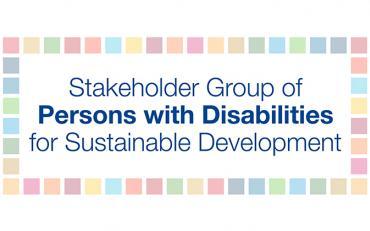Background
Due to accessibility barriers for participants with disabilities, the Stakeholder Group of Persons with Disabilities (SGPwD) met with the UN Department for General Assembly and Conference Management (DGACM)during the 2016 High-level Political Forum (HLPF) to discuss making future HLPFs accessible. Afterwards, we met to collaborate on making 2017 HLPF inclusive for persons with disabilities and it was decided to periodically meet. Subsequently, Dr. Elizabeth Lockwood from CBM Global was appointed as the focal point on accessibility for the Stakeholder Group of Persons with Disabilities. Her contact details are here: elizabeth.lockwood [at] cbm-global.org
The following accessibility outcomes resulted from recommendations that were compiled from consultations with the disability community. These accommodations have been provided mainly at the HLPF, although also have been and can be used in other UN events, including Regional Forums for Sustainable Development, the Forum on Science, Technology and Innovation for the Sustainable Development Goals, the UN Commission on the Status of Women, and the UN World Data Forum.
The following accessibility outcomes emerged from 2017, 2018 and both 2019 HLPFs:
- Communication Access Realtime Translation (CART) services were provided for deaf and hard of hearing participants for all HLPF plenary sessions in the room on the screen and online.
- International Sign interpretation was provided for the Ministerial Segment of the HLPF.
- Captions for all of the HLPF sessions were included in the UN webcast live and recorded videos, and additionally, International Sign interpretation was included during the Ministerial Segment.
- Portable audio translation devices were distributed for wheelchair users and sign language interpreters in the gallery for all the sessions.
- Specific seats for persons with disabilities and their personal assistants with ample space to manoeuvre were reserved in all relevant conference rooms.
- The HLPF and sustainable development knowledge platform websites have created accessible features, including Word documents and alt-text descriptions for images.
- Presentation materials, when possible, were shared in advance with sign language interpreters and CART providers.
- Braille copies of the HLPF agenda and presentations for speakers were easily and quickly provided.
- An accessibility walk-through took place well in advance of the HLPF.
- Security was briefed on disability and accessibility awareness before each week of the HLPF and as a very positive outcome, participants’ experiences were very positive with security.
- Signage on the availability of plastic straws for persons with disabilities is now visible at UN cafeterias;
- More time was given to presenters with disabilities, at least a minute more than presenters without disabilities, especially for the blind and low vision participants reading Braille, deaf and hard of hearing participants using sign language, and participants with speech disabilities.
- A temporary dog relief area was designated for visitors with guide or service dogs in collaboration with UN security and the K9 unit.
We continue to collaborate with the UN Secretariat and other entities in close consultation with organizations of persons with disabilities to ensure accessibility and inclusion are carried out at the UN. Please note that we are continually updating accessibility recommendations and resources and welcome any inputs and suggestions.
Relevant Resources
- Recommendations for accessibility at in-person and online events and meetings
- 2020 HLPF Accessibility Recommendations
- Checklist for making virtual meetings accessible
- Overview on Accessibility of Video Conferencing Apps and Services – periodically updated
- Accessibility Guide for Visitors to the United Nations Headquarters – periodically updated
- Accessibility Recommendations for HLPF September 2019
- Stakeholder Group of Persons with Disabilities recommendations for UN Security (September 2019)
- Toolkit: Accessible Meetings
